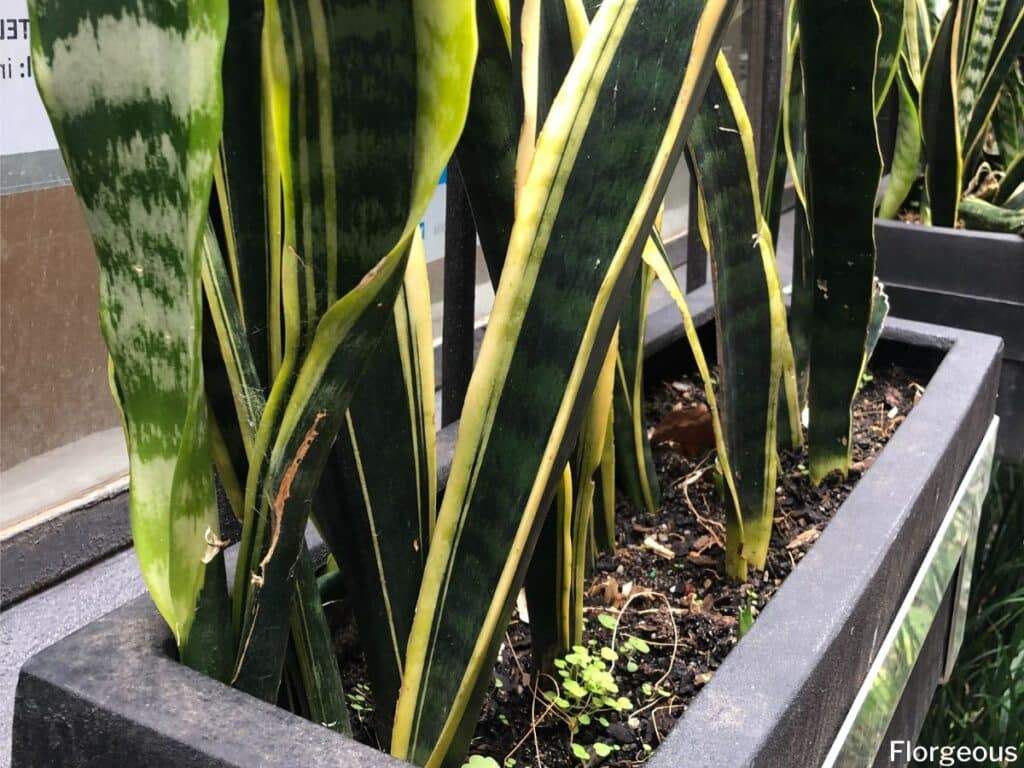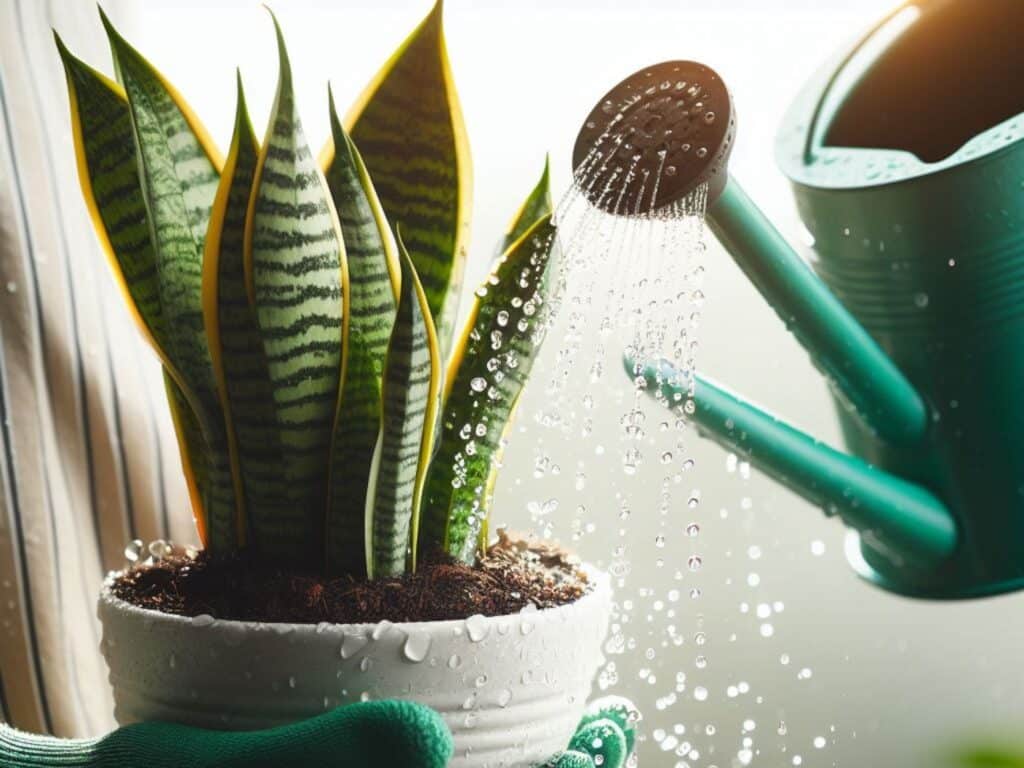Discovering your snake plant’s leaves turning soft and yellow can be disheartening, especially when you’ve been diligently caring for it. Often, this distress signal points to a common culprit: overwatering.
This mistake is easy to make but can have serious consequences for your resilient green friend. Understanding the signs of overwatering, its impact on your snake plant, and the steps to remedy the situation is crucial in reversing the damage and preventing future occurrences.
Fortunately, there’s hope for your overwatered snake plant. With the right knowledge and a bit of patience, you can nurse your plant back to health.
This article will guide you through identifying the problem, understanding why it happens, and providing practical solutions to ensure your snake plant thrives once more. Let’s dive into how you can save your overwatered snake plant and ensure it continues to be a vibrant part of your home.
Identifying an Overwatered Snake Plant

Signs and Symptoms
Recognizing an overwatered snake plant is crucial for its recovery. The earliest sign is often yellowing leaves. Unlike healthy snake plants, which boast stiff, upright leaves, those suffering from too much water will feel soft and mushy.
The moist soil, more often than not, clings to the roots longer than it should, leading to root rot—a serious condition indicated by a foul odor emanating from the pot. Spotting these symptoms early on can be the difference between saving your plant or learning a hard lesson in plant care.
Comparing Overwatering and Underwatering
Distinguishing between overwatering and underwatering is essential, as both can lead to yellowing leaves but require different remedies.
Overwatered snake plants feature leaves that are not only yellow but also soft and drooping. They may well even start falling over due to the weakened base. On the flip side, underwatered plants exhibit dry, wrinkly leaves that still maintain their rigidity.
The soil? It’s as dry as a desert, quite literally pulling away from the pot’s edges. Matching the symptoms with the correct issue ensures you don’t accidentally drown your plant or leave it thirsting for more.
Causes of Overwatering
Understanding why your snake plant may well be getting too much water is key to reversing the issue and fostering a healthier environment for your green buddy. Let’s delve into the common culprits that lead to overwatering.
Incorrect Watering Schedule
One main reason your snake plant suffers is an incorrect watering schedule. These resilient plants thrive on neglect, believe it or not. They prefer drying out between waterings.
If you’re reaching for the watering can more than once a week, it’s time to pull back. An overeager watering routine can quickly lead to waterlogged soil, suffocating the roots and mimicking signs of drought stress, which is, ironically, what you were trying to avoid.
Inadequate Drainage
Imagine wearing wet socks all day. Unpleasant, right? That’s how your snake plant feels in a pot without proper drainage. Good drainage is crucial, yet it’s often overlooked.
Ensure your pot has ample holes at the bottom to let excess water escape. If not, you’re basically inviting water to stick around for a pool party at your plant’s roots, leading to root rot. Also, consider the potting mix—it should be light and airy, promoting moisture control without becoming waterlogged.
Environmental Factors
Lastly, don’t forget to consider environmental factors that play a significant role in water retention. High humidity, low light, and cool temperatures can all contribute to slower soil drying.
If your plant is in a dimly lit room or a naturally humid environment, it won’t need water as often as you may well think. Adjust your watering schedule to match the environment, and you’ll be on your way to rehabilitating your overwatered snake plant in no time.
Consequences of Overwatering

When you give your snake plant a little too much love in the form of water, you may well not realize the havoc you’re wreaking below the soil. Let’s dive into what happens when your green thumb gets a bit too generous.
Root Rot and Fungal Infections
Root rot turns the powerhouse of your snake plant—the roots—into mush. This condition doesn’t just stop at making the roots look sad and soggy; it invites fungal infections to the party. These fungi aren’t the fun type you’d find in a forest; they’re the kind that makes your plant’s roots their home, further damaging the plant. If your snake plant’s soil smells more like a swamp than fresh earth, root rot could be the uninvited guest causing trouble.
Stunted Growth and Yellowing Leaves
Overwatering doesn’t just keep your snake plant from growing; it turns it into a yellow mess. The leaves, once sturdy and upright, may start drooping, looking more like overcooked spaghetti than the perky plants they once were. This yellowing and stunted growth aren’t just an aesthetic issue.
They’re signs your plant is struggling to breath and perform photosynthesis, the very process it relies on for food and growth. So, if your snake plant’s leaves are more yellow than green, it’s time to reassess your watering routine.
Treating an Overwatered Snake Plant
Salvaging the Plant
First off, don’t panic. An overwatered snake plant isn’t a lost cause. Start by checking the roots; gently remove the plant from its pot. Healthy roots are firm and white.
If you spot any mushy, brown roots, it’s time for surgery. Using sterilized scissors, trim away the damaged parts. Let the roots air out for a day. This helps prevent further fungal infections. Now, it’s repotting time.
Choose a pot with ample drainage holes and fresh, well-draining soil specifically mixed for succulents or cacti. Replant your snake plant, but hold off on the water. Give it a week to settle into its new home. During this period, keep your plant in indirect sunlight. Too much direct sun can stress it further.
Preventing Future Overwatering
The lesson here is clear: more water doesn’t mean more love. To avoid a repeat performance, let’s refine your watering technique.
Snake plants thrive on neglect. They prefer to dry out between waterings. Stick your finger about an inch into the soil. If it feels dry, it’s time to water.
If not, show some restraint. Also, consider the season. Snake plants need less water in the cooler months. And don’t forget the environment. Low light and cooler temperatures mean even slower water absorption.
Adjust accordingly. Lastly, ensure your plant’s pot has good drainage and use soil that doesn’t hold onto moisture for too long. With a bit of care and a watchful eye, you’ll have a thriving snake plant that’s both healthy and happy.
Preventative Measures for Healthy Snake Plants
Growing a healthy snake plant doesn’t have to be a challenge if you follow these simple preventative measures. Keeping your snake plant thriving involves not just reacting to issues like overwatering but proactively taking steps to avoid them. Let’s dive in.
Proper Watering Techniques
Remember, your snake plant is more of a camel than a fish; it stores water in its leaves and prefers to stay on the dry side. The key to proper watering is to wait until the topsoil feels dry to the touch, which typically means watering every 2-3 weeks.
However, adjust this schedule based on the humidity and temperature of your home. During winter, snake plants need even less water, so keeping a check on the soil’s moisture level before reaching for the watering can is a smart move.
Choosing the Right Soil and Pot
Selecting appropriate soil and a pot can be game-changing for your snake plant. Opt for a well-draining potting mix, commonly found in stores as “succulent mix,” to give your plant the drainage it craves.
When it comes to pots, always choose one with sufficient drainage holes at the bottom. This setup helps prevent water from pooling at the roots, reducing the risk of overwatering and root rot significantly.
Monitoring Environmental Conditions
Your snake plant isn’t asking for much—just a spot that isn’t too hot or too cold, with indirect light. It’s a pretty hardy plant that can tolerate low light but thrives in moderate to bright, indirect sunlight. Be mindful of the air around your plant too.
Extreme temperature changes and drafts can stress your plant, leading to weakened defenses against issues like overwatering. Keep your plant in a stable environment, and it will thank you with robust health and striking appearance.
Up next: Overwatered Christmas Cactus: Revival Tips & Long-Term Care







